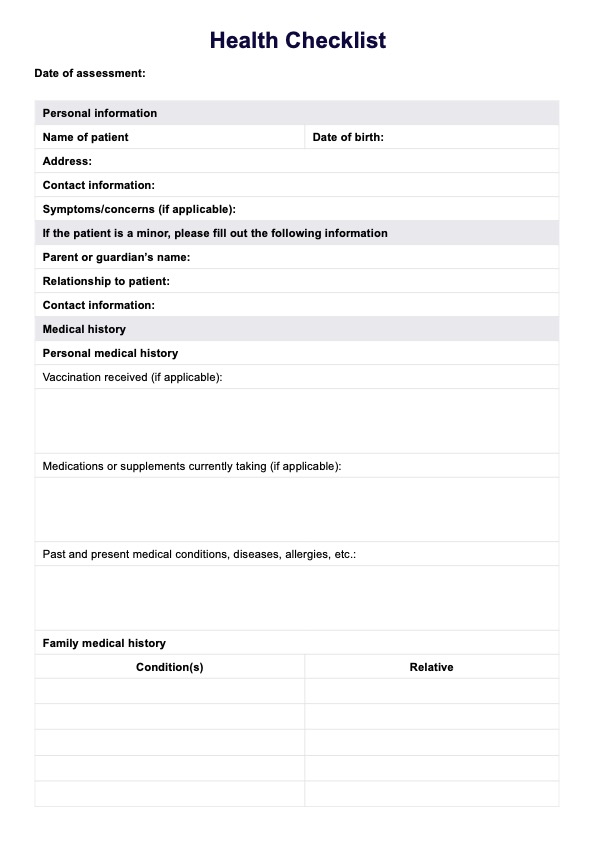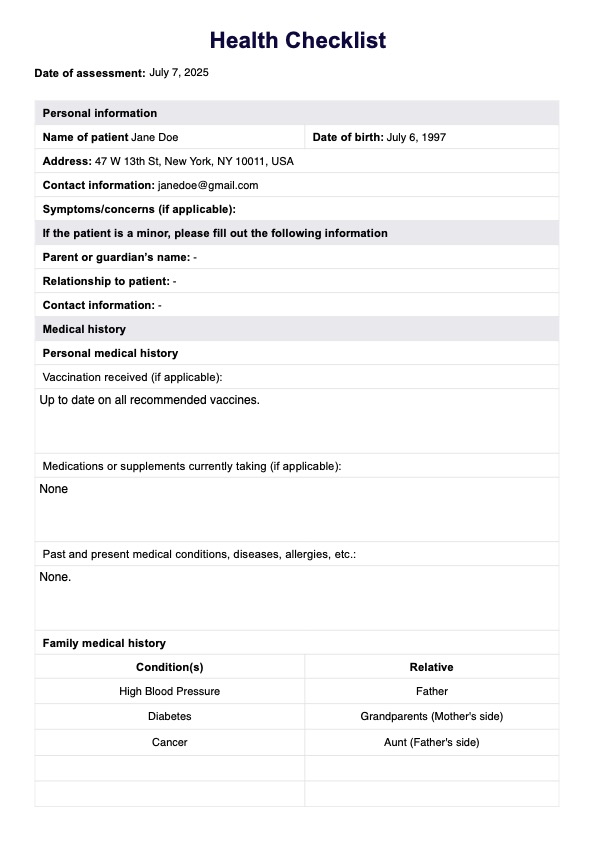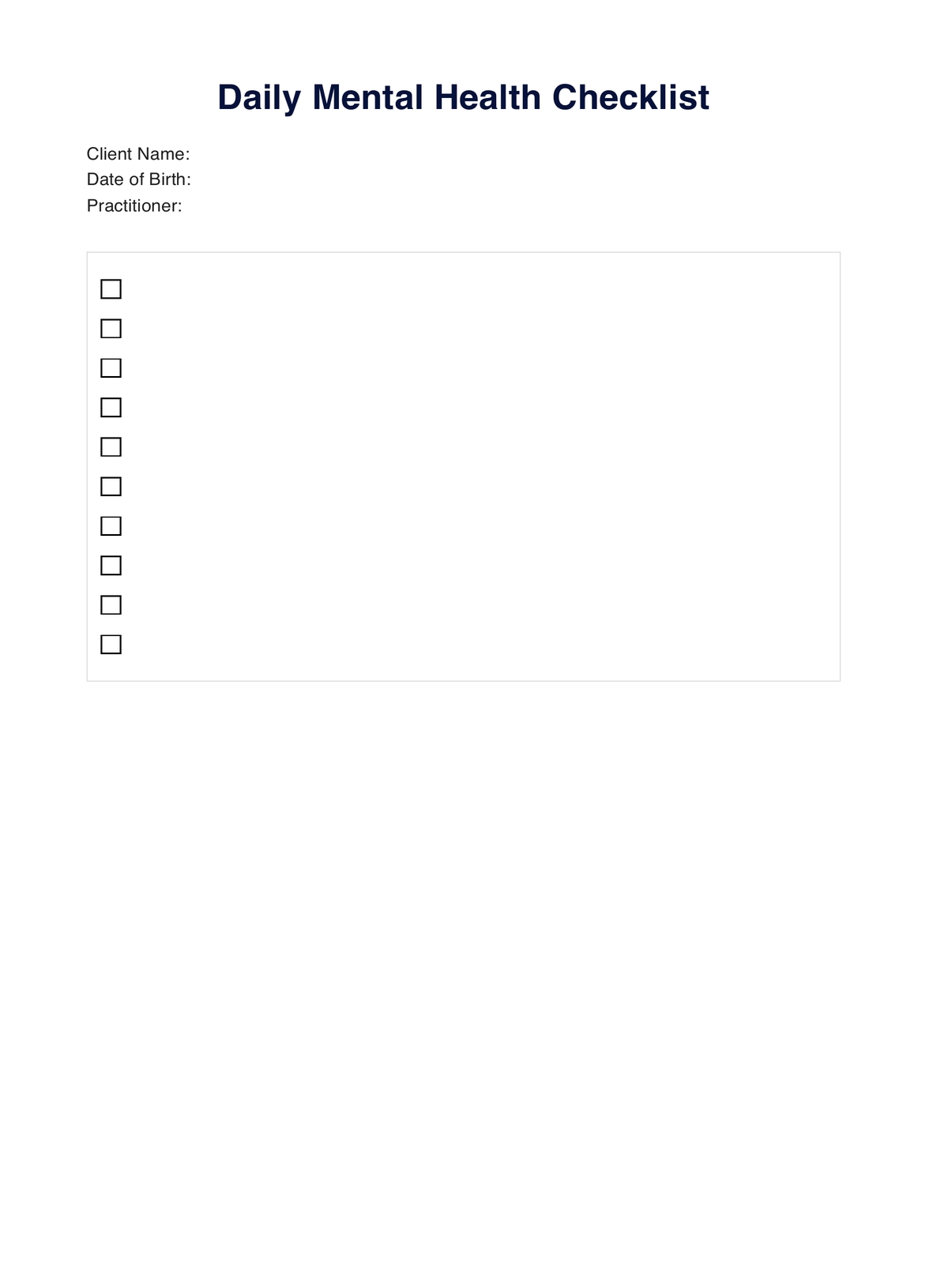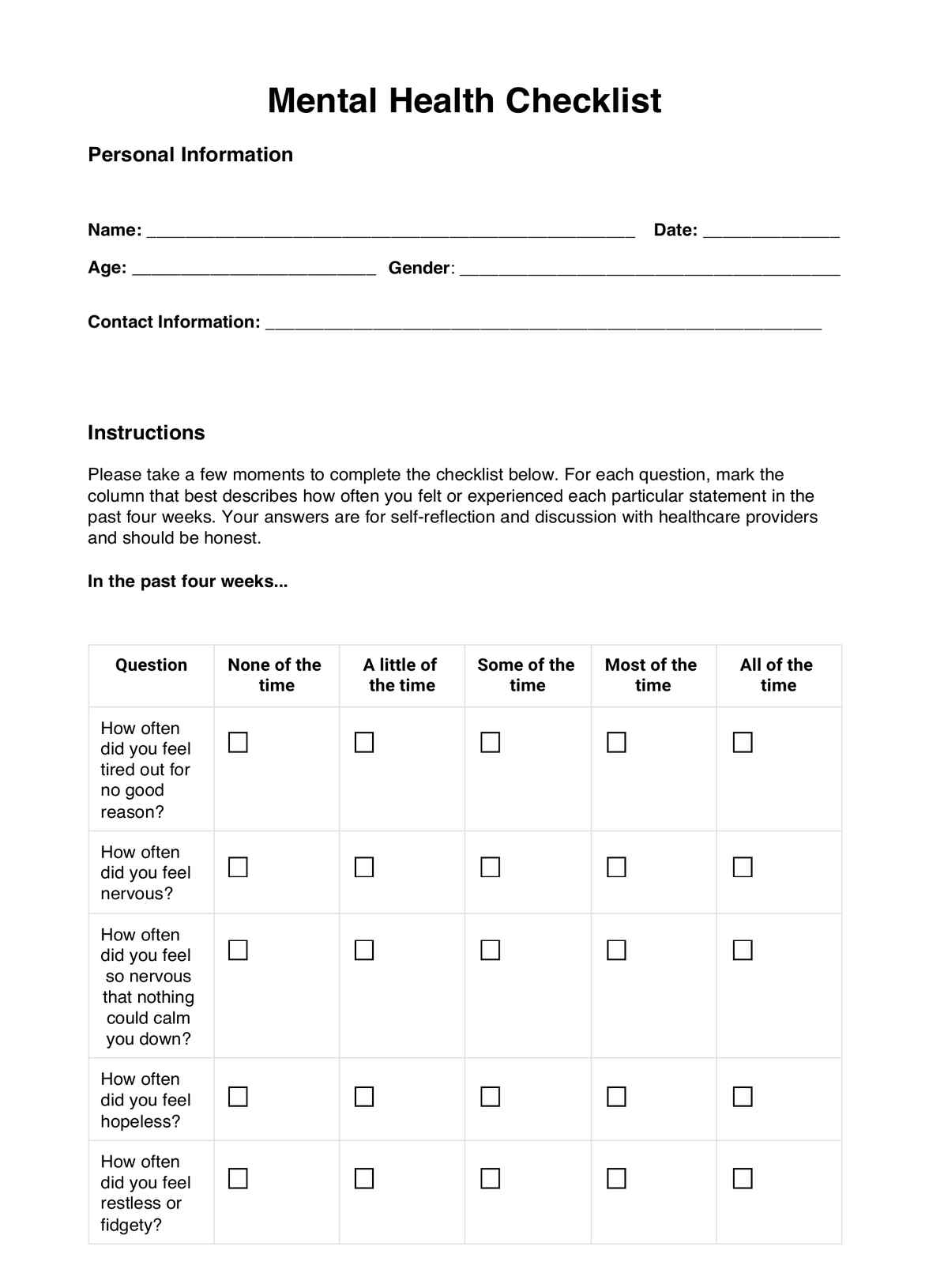Health Checklist
Discover how to enhance patient care with our Health Checklist guide. Includes practical examples and a free PDF download for healthcare professionals.


What is a Health Checklist?
Did you know that a simple tool could be pivotal in preventing common but serious health issues like high blood pressure, heart disease, and various types of cancer?
A health checklist is an essential instrument, serving as a proactive approach to healthcare. By systematically addressing risk factors for diseases such as breast, lung, and skin cancer and focusing on maintaining cardiovascular health, a health checklist empowers individuals to lead healthy lives. It encompasses elements crucial for heart, mental, and overall well-being, such as adhering to a balanced diet and understanding one's family history of health issues.
It's a personalized roadmap to navigating the complex terrain of health maintenance and disease prevention, ensuring that patients and healthcare providers can work together to achieve optimal health outcomes.
Health Checklist Template
Health Checklist Example
When to share Health Checklists with patients
Determining when to provide patients with a health checklist is crucial for maximizing effectiveness. The ideal moment often coincides with a patient's readiness to take proactive steps toward improving their overall health. For instance, when blood pressure, body metrics, sleep patterns, exercise habits, and dietary intake are discussed during consultations, a health checklist becomes invaluable.
It serves as a tailored guide that encourages patients to monitor and adjust their lifestyle choices—focusing on balanced food intake, especially fruits and vegetables, regular physical activity to combat obesity, and strategies to manage high cholesterol.
Introducing the checklist when setting health goals gives patients a clear, actionable plan that aligns with their health needs, ensuring a comprehensive approach to maintaining and enhancing their well-being.
Key components of a Health Checklist
What exactly comprises a health checklist? At its core, a health checklist covers all aspects of an individual's well-being, ensuring that common and specific health challenges are addressed effectively. The key components include:
- Screening test recommendations: A list of necessary screening tests tailored to the individual’s age, sex, and family history, helping in the early detection of diseases.
- Physical activity guidelines: Suggestions for staying physically active, including types of activities and daily or weekly exercise goals to keep the body strong and healthy.
- Nutritional advice: Guidelines on eating a balanced diet rich in fruits and vegetables and recommendations to avoid high-risk foods, such as those high in sugar or saturated fats, including a caution against regular soda consumption.
- Sleep recommendations: Information on the importance of sleep, including strategies to achieve quality sleep and avoid sleep deprivation, emphasizing the normal range of hours needed for different age groups.
- Stress management techniques: Tools and techniques for managing stress effectively, acknowledging that stress can significantly impact physical and mental health.
- Body metrics monitoring: Encouragement to regularly monitor body metrics such as blood pressure and cholesterol levels, ensuring they remain within a normal range.
- Lifestyle choices: Advice on making healthy lifestyle choices to reduce the risk of developing chronic diseases, with specific actions such as reducing alcohol intake and quitting smoking.
By integrating these elements, a health checklist is a comprehensive guide for individuals to follow, aiming to maintain or improve their health status. It provides a snapshot of what it means to live a healthy life and offers a structured approach to tackling health-related goals and challenges.
Benefits of using the checklist
Introducing a health checklist into one’s routine can be a game-changer for managing and improving health. Below are five significant benefits that highlight its importance and effectiveness:
Comprehensive risk assessment
Utilizing a health checklist allows individuals to thoroughly assess health risks based on their family history and lifestyle choices. For adults with a history of heart disease, breast cancer, or high blood pressure, the checklist can guide them toward specific screening tests like mammograms for breast cancer or low-dose CT scans for lung cancer and proactive measures for maintaining cardiovascular health.
It's a tool for identifying potential health issues before they escalate, including chronic diseases like type 2 diabetes and common cancers such as skin, prostate, and colorectal cancer.
Promotion of a healthy lifestyle
The checklist encourages a healthy lifestyle by emphasizing the importance of a balanced diet, regular physical activity, and adequate sleep. It inspires individuals to eat whole foods, reduce consumption of certain foods that contribute to high cholesterol and high blood pressure, like processed foods and soda, and increase intake of fruits, vegetables, and whole grains.
This guidance helps stay physically active and manage weight, which is crucial for preventing obesity and its related health challenges.
Enhanced disease prevention
By following recommendations for regular screenings and adopting health-conscious behaviors, individuals can significantly lower their risk of developing serious conditions like heart disease, skin cancer, and cervical cancer.
For sexually active adults, the checklist can also remind them to get screened for sexually transmitted infections, thus ensuring early detection and treatment of conditions that might otherwise go unnoticed until more severe symptoms develop.
Tailored health management
The health checklist is adaptable, allowing for personalization based on health goals, risks, and challenges. It offers a tailored approach to managing health, whether getting blood pressure checked, monitoring blood sugar levels for diabetes, or undergoing a skin cancer check for suspicious dark spots.
This personalized aspect ensures that the advice and steps taken are relevant and effective for each individual’s situation.
Supports mental and emotional well-being
Mental health is a crucial component of overall health, and the checklist addresses this by including elements like stress management and ensuring sufficient sleep to combat sleep deprivation. It promotes practices that contribute to mental wellness, such as moderate physical exercise, eating a diet rich in plant-based foods, and engaging in activities that reduce stress.
This holistic approach ensures that health is viewed and managed, incorporating physical and mental aspects to support a healthy life.
A health checklist is a multi-faceted tool that guides individuals toward achieving and maintaining optimal health through prevention, early detection, and managing existing conditions. It empowers people to take control of their health, making informed decisions that enhance their quality of everyday life.
Key beneficiaries of the Health Checklist
The health checklist is a versatile tool that offers significant benefits across various individuals and organizations. Here are three primary beneficiaries:
Individual adults seeking to prevent chronic conditions
Proactive adults can use the checklist to monitor and manage key health indicators such as blood sugar levels, dietary habits, and physical activity. This is particularly beneficial for those at risk of or aiming to prevent heart disease and diabetes.
By adhering to guidelines on how often to eat fruits and vegetables, limiting the intake of soda and processed foods, and maintaining regular physical exercise, individuals can significantly reduce their risk of developing these common chronic conditions.
Doctors and healthcare providers
Medical professionals can leverage the health checklist as a communication tool to educate patients about the importance of regular screenings for common cancers and other diseases. It helps set tangible health goals for patients and offers a structured approach to tracking progress weekly.
Additionally, doctors can use it to personalize advice for patients based on their specific health needs, making it easier to manage conditions like diabetes and monitor heart health through diet and lifestyle adjustments.
Health organizations and wellness programs
Other organizations, including public health agencies and corporate wellness programs, can benefit from distributing health checklists to their populations. These organizations can use the checklist to promote awareness about the risks associated with poor dietary habits, the importance of physical activity, and the need for regular health screenings.
By encouraging individuals to drink less soda, eat a balanced diet, and stay active, these organizations play a crucial role in preventing obesity, diabetes, heart disease, and other conditions linked to lifestyle and dietary choices.
The health checklist is a powerful resource for anyone interested in improving their health or supporting others in their journey towards a healthier lifestyle. It acts as a roadmap for individuals and professionals, offering clear guidelines and actionable steps to achieve better health outcomes.
Commonly asked questions
Positive lifestyle factors include maintaining a balanced diet, engaging in regular physical activity, ensuring adequate sleep, managing stress effectively, and avoiding harmful habits such as smoking and excessive alcohol consumption. These factors contribute to overall health and well-being, reducing the risk of chronic diseases.
Staying healthy involves eating various nutritious foods, being physically active every day, getting sufficient rest, staying hydrated, managing stress, and keeping up with regular health check-ups and screenings. Adopting these habits supports physical and mental health.
A health checklist can be instrumental in managing chronic conditions by providing a structured way to monitor daily health behaviors, medication adherence, and appointment schedules. It encourages regular health screenings and tests critical for early detection and management of conditions such as diabetes, heart disease, and high blood pressure.
A health checklist can help individuals better control their condition, minimize complications, and enhance their quality of life by focusing on preventive care, lifestyle modifications, and routine monitoring.









































































































